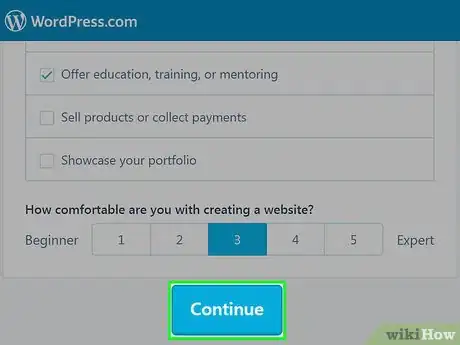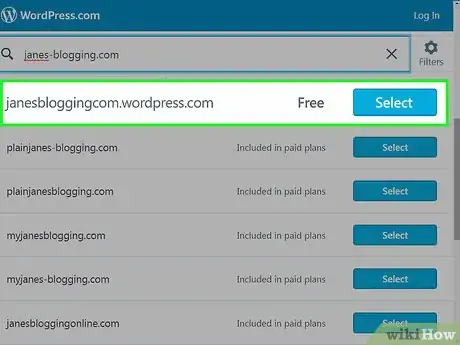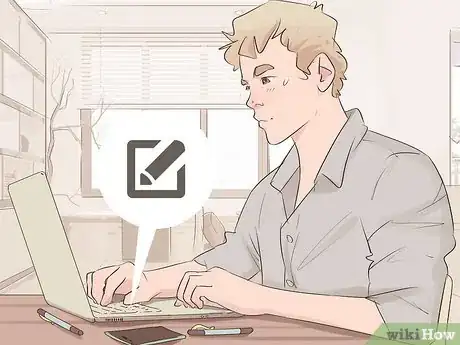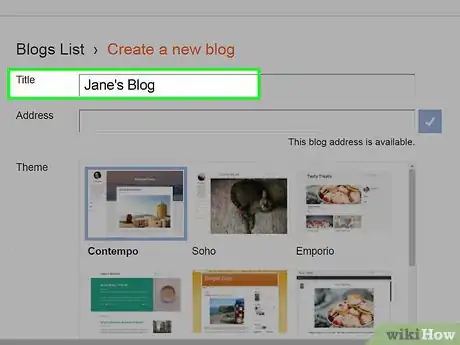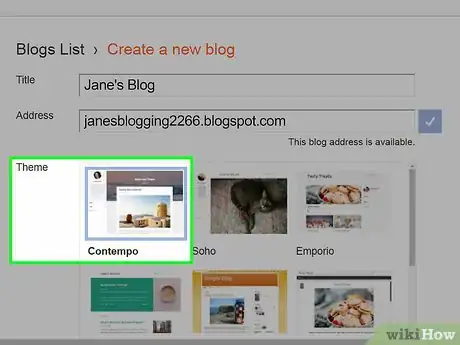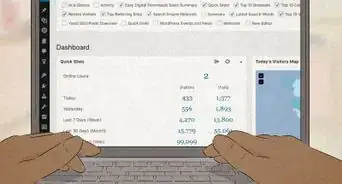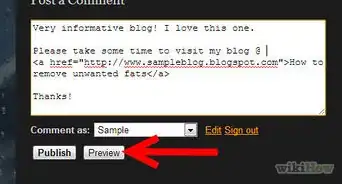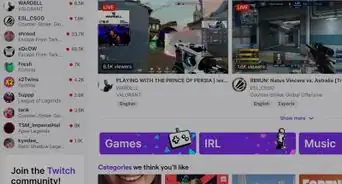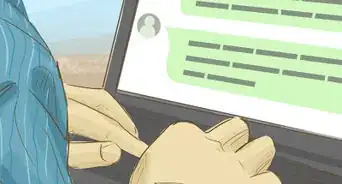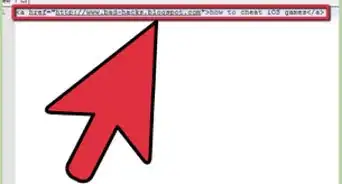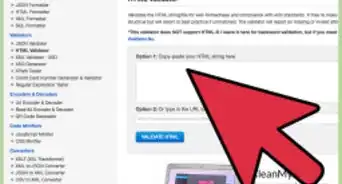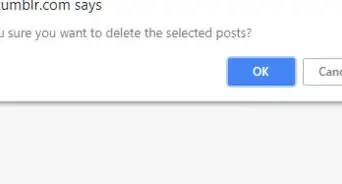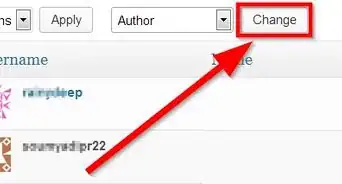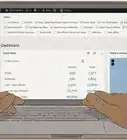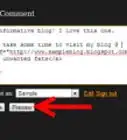This article was co-authored by Maureen Taylor and by wikiHow staff writer, Jack Lloyd. Maureen Taylor is the CEO and Founder of SNP Communications, a leadership communications company based in the San Francisco Bay Area. She has been helping leaders, founders, and innovators in all sectors hone their messaging and delivery for almost 30 years, and has worked with leaders and teams at Google, Facebook, Airbnb, SAP, Salesforce, and Spotify.
There are 11 references cited in this article, which can be found at the bottom of the page.
The wikiHow Tech Team also followed the article's instructions and verified that they work.
This article has been viewed 5,081,062 times.
Blogging is a very popular passive income stream. You may see many people call themselves bloggers. If you want to become one of them and put forth your views onto the internet and spread knowledge, this wikiHow is perfect for you. This WikiHow teaches you how to create and begin using a blog, both in general and by using specific platforms such as WordPress and Blogger.
Steps
Creating a Successful Blog
-
1Come up with a list of interests.[1] Before you define your blog's intention, you should have a general idea of what you want to write about. These interests/categories which you are going to write about is known as your blog's niche. The sky is the limit when it comes to your blog's niche, but common topics include the following:
- Gaming
- Style
- Politics/Social Justice/Activism
- Cooking/Food
- Travel
- Business/Company
-
2Know what not to blog about. Things like private information—both yours and other people's—and personal details that you don't want to share with people close to you shouldn't be topics for your blog. Also, controversial articles or posts may get you some temporary popularity but it also comes with cons like less safety and targeting.
- If you have a job that required you to sign an NDA (non-disclosure agreement), you should avoid discussing activities or topics outlined in the NDA.
- Blogging about other people is fine as long as you don't harass or discriminate against them, but be aware that they may see your content and retaliate.
Advertisement -
3Consider your blog's intention. While having in mind a blog topic is a good start, your blog needs a specific direction in order to get off the ground.[2] Common reasons for blogging include one (or a combination) of the following, though you can certainly find your own inspiration:[3]
- Teach something — Best-suited to instructional blogs (e.g., DIY projects).
- Document your experience — Good for travel blogs, fitness challenges, and so on.
- Entertain — Well-suited to a variety of mediums such as comedy writing, fan-fiction, and so on.
- Call to action — Commonly used for your business or company blog.
- Inspire others — This is a category that can stand on its own, but may best fit any of the other intentions in this section.
- "Spread Awareness" - Useful for news blogs.
-
4Check out other blogs in your category. Once you've established your blog's topic and goal, research other blogs that use the same topic and/or your preferred style of writing to see how they engage their audiences.
- You shouldn't outright copy a blog you admire, but you can take inspiration from the tone, layout, or language used for the blog content itself. Seeing really popular and awesome blogs in your niche can pull you towards plagiarizing the writing style or even the content, but be sure to just take inspiration from it, you will be discovered someday or another if you plagiarize.
-
5Brainstorm blog specifics. The last two things you should know before you actually make your blog are the blog's name and how you want the blog to look:[4]
- Blog name — Come up with a name that you feel comfortable sharing with others. This may be a combination of your interests, your blog's content, and/or a nickname; just make sure that your blog's title is both unique and easy to remember.
- Blog design — You probably won't be able to design your blog's layout exactly the way you want to, but having a general idea of the color scheme and font type before you go to create your blog will make it easier to find a template you like.
-
6Create your blog using a reputable platform. Common blog platforms include WordPress, Blogger, and Tumblr, but you can choose any commonly used service you like. Once you've selected a service, your blog creation process will usually look something like this:
- Open the service's website on your computer.
- Create an account (preferably a free one to start).
- Enter your desired blog name, then pick a URL.
- Select a blog layout and any other requested details.
-
7Promote your blog on social media. Once you've created your blog and made a few posts, you can increase your blog traffic by posting a link to your blog on social media sites such as Facebook and Twitter.[5]
- You might even consider using the blog's address in your bio or as your "Company Website" on social media.
-
8Research keywords for your posts. "Keywords" are words which both pertain to your blog's topic and have a high search engine rating. Using keywords in your blog posts will make it easier for people who look up those words to find your content.[6]
- Keyword generator sites such as http://ubersuggest.io/ or https://keywordtool.io/ will come up with a list of words that relate to your blog's topic.
- Re-check the keywords you use every time you create a blog post.
- If you fit the keywords into your posts in a natural way, search engines will be more likely to pick up on your blog than if you just scatter them throughout the posts.
-
9Get your blog indexed by Google. Ensuring that your blog is indexed by Google will increase your search engine ranking, making it easier for people to find your blog when they look up related keywords.[7]
-
10Use images in your posts. One thing that search engines tend to prioritize over all else is image use, so make sure your posts have high-quality images attached to them.[8]
- You may get bonus points for original photos.
- Users tend to appreciate visual input alongside text, so adding images to your blog is a good idea even if you aren't worried about search engine optimization.
-
11Keep posting content.[9] Little will cause your blog to stop drawing in traffic faster than not posting for a long period of time (or posting erratically). Develop a posting schedule that allows you to post at least once per week and stick to it.
- Missing a post by a day or two once in a while is fine, though you should consider making a note on social media that your post will be late.
- Fresh content will also help keep your blog near the top of search engine results.
Creating a Blog in WordPress
-
1Open WordPress. Go to https://wordpress.com/ in your computer's web browser.[10]
-
2Click Get Started. It's a link in the upper-right corner of the page.
-
3Fill out the blog creation form. Enter your information into the following fields:
- What would you like to name your site? — Enter your blog's name here.
- What will your site be about? — Type in a one-word category, then click a category that fits your blog in the resulting drop-down menu.
- What's the primary goal you have for your site? — Type in a one-word category, then click a category that fits your blog in the resulting drop-down menu.
- How comfortable are you with creating a website? — Click one of the numbers at the bottom of the page.
-
4Click Continue. It's at the very bottom of the page.
-
5Enter your preferred address for your blog. In the top text box, type in whatever you want your blog's URL name to be.
- Don't include the "www" or ".com" part of the URL here.
-
6Click Select next to the "Free" option. This option will appear below the text box. Doing so selected the free address for your blog.
-
7Click Start with Free. It's on the left side of the page. Doing so will take you to the account creation page.
-
8Enter an email address. Type the email address you want to use to create your account into the "Your email address" text box.
-
9Enter a password. Type a password for your account into the "Choose a password" text box.
-
10Click Continue. It's a blue button at the bottom of the page.
-
11Confirm your email address. While you're waiting for WordPress to finalize your account details, do the following:
- Open your WordPress email inbox in a new tab.
- Click the "Activate [blog name]" email from "WordPress".
- Click Click here to Confirm Now in the email body.
- Close the tab once it finishes loading.
-
12Click Continue. It's in the middle of the original tab on which you created your WordPress account.
-
13Add a theme to your blog. The "theme" dictates how your blog looks. Scroll down to the "Customize" heading, click Themes, and select the theme you want to use for your blog. You can then click Activate this design at the top of the page.
- You might want to click Free in the upper-right side of the page to see results for free themes only.
-
14Start writing. You can start your first blog post by clicking Write in the upper-right side of the window to bring up the post window; at this point, you're free to begin creating content for your blog.
Creating a Blog in Blogger
-
1Open Blogger. Go to https://www.blogger.com/ in your computer's web browser.[11]
-
2Click SIGN IN. It's in the top-right corner of the page.
-
3Sign in using your Google Account. Enter your email address, click Next, and then type in your password and click Next.
- If you don't have a Google Account, create one before proceeding.
-
4Click Create a Google+ profile. It's a blue button on the left side of the page.
-
5Enter your name. Type your first and last name into the text boxes at the top of the page.
-
6Select a gender. Click the gender drop-down box, then click the gender you want to use for your blog.
-
7Click CREATE PROFILE. It's at the bottom of the page.
-
8Add a photo. Click your current photo, click Upload a photo when prompted, and then find and double-click a photo on your computer. You can then click SAVE to proceed.
- You can also click SKIP below this section to add a photo later.
-
9Click Continue to Blogger. You'll find this option near the bottom of the page.
-
10Click CREATE NEW BLOG. It's in the middle of the page.
-
11Enter a blog title. Type your blog's title into the "Title" text box.
-
12Select a blog address. Type the address you want to use into the "Address" text box, then click the address that appears below it in a drop-down menu.
- If Google indicates that the address is already taken, you'll need to choose a different address.
-
13Select a theme for your blog. Click a theme in the "Theme" list.
- The theme determines how your blog will appear.
-
14Click Create blog!. It's at the bottom of the window.
-
15Click No thanks when prompted. Doing so takes you to the blog's dashboard.
-
16Start writing. Click New post at the top of the page to open the blog post window; at this point, you're free to begin creating content for your blog.
Sample Blog Post
Expert Q&A
Did you know you can get expert answers for this article?
Unlock expert answers by supporting wikiHow
-
QuestionHow do you write a blog as a beginner?
 Maureen TaylorMaureen Taylor is the CEO and Founder of SNP Communications, a leadership communications company based in the San Francisco Bay Area. She has been helping leaders, founders, and innovators in all sectors hone their messaging and delivery for almost 30 years, and has worked with leaders and teams at Google, Facebook, Airbnb, SAP, Salesforce, and Spotify.
Maureen TaylorMaureen Taylor is the CEO and Founder of SNP Communications, a leadership communications company based in the San Francisco Bay Area. She has been helping leaders, founders, and innovators in all sectors hone their messaging and delivery for almost 30 years, and has worked with leaders and teams at Google, Facebook, Airbnb, SAP, Salesforce, and Spotify.
Communications Coach
-
QuestionHow old do I have to be to start a blog?
 Community AnswerProvided you have time and parental permission, any age is fine. However, you do open yourself to online criticism and rudeness, so bear that in mind before starting a blog.
Community AnswerProvided you have time and parental permission, any age is fine. However, you do open yourself to online criticism and rudeness, so bear that in mind before starting a blog. -
QuestionCan I be an anonymous blogger?
 Community AnswerYes, on the Internet you can always remain anonymous. If it asks for your name, just say a word relating to your blog as your first name and "Blogger" as your last name.
Community AnswerYes, on the Internet you can always remain anonymous. If it asks for your name, just say a word relating to your blog as your first name and "Blogger" as your last name.
Warnings
- Remember that what you post is visible to the world, so be careful about how much information you share. Also, in certain countries, blog posts that are critical of the government or otherwise "offensive" could get you into serious trouble. Be smart about what you post.⧼thumbs_response⧽
- Prepare yourself for some unkind comments, especially if you are blogging about sensitive topics.⧼thumbs_response⧽
- Be wary of unwarranted attention. Don't give out personal information such as your full name, your location, or other identifying attributes.⧼thumbs_response⧽
- Avoid posting anything that infringes on the privacy of others if you allow everyone to read your blog. If something is personal, avoid using last names at the very least, or make up a name for that person. Also, never post private pictures of other people without their permission.⧼thumbs_response⧽
References
- ↑ Maureen Taylor. Communications Coach. Expert Interview. 6 March 2019.
- ↑ Maureen Taylor. Communications Coach. Expert Interview. 6 March 2019.
- ↑ https://www.managementstudyguide.com/different-types-of-blogs.htm
- ↑ https://www.highervisibility.com/blog/spark-your-creativity-with-this-brainstorming-activity/
- ↑ https://firstsiteguide.com/promote-content/
- ↑ https://firstsiteguide.com/keyword-research/
- ↑ https://en.support.wordpress.com/search-engines/
- ↑ https://www.nngroup.com/articles/photos-as-web-content/
- ↑ Maureen Taylor. Communications Coach. Expert Interview. 6 March 2019.
About This Article
To start a blog, think of a topic you’re passionate about and brainstorm ways to write about it to help others. Take a look at similar sites and tailor yours so that it stands out from the crowd. Come up with a name that will attract attention, with keywords to help it pop up in a search engine. Choose a platform, like WordPress or Blogger, and write a few posts, making sure to proofread. Once you publish your first few posts, start promoting your blog on social media to drive up traffic. For topic ideas and technical tips on getting your blog running, read on!















